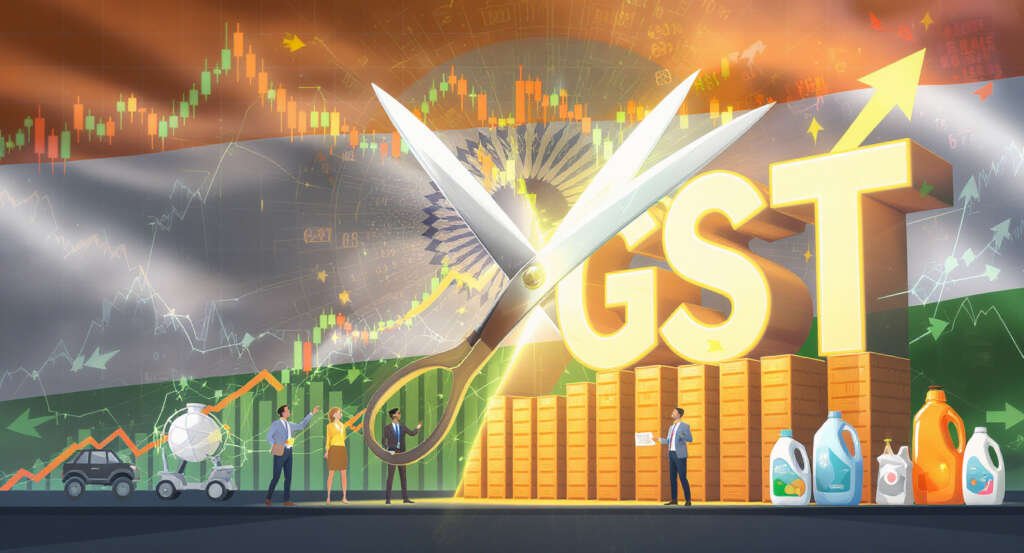The GST (Goods and Services Tax) is an irremovable part of the Indian Tax system, which was introduced in 2017. It was a revolutionary economic development in the history of post-independent India.
This impacted the share of indirect taxes at the central and state levels, including excise duty, VAT, service tax, and the whole nation’s financial system. GST makes the tax structure simple and powerful, and promotes more business in the Indian economy. Its effects extend from the starting point to the consumption of a product, which means the GST influence ranges from the manufacturing cost of goods to the end price when the consumer buys it.
The rate cut announcement invoked a spontaneous reaction from the Indian stock market. It created a sharp market rally in consumption sectors like FMCG, cement, and automobiles. The Nifty made a gain of nearly 500 points in a day.
Pillar of India’s Economy
GST’s impact affects all parts of the financial system in the Indian economy. The country’s economy is a consumption-led economy where the demand will be stimulated when the tax burden is reduced. GST makes businesses formalise and improve corporate transparency, and the new simplified version aims to reduce confusion, disputes, improve investor confidence and compliance. It can transform lower taxes into volume growth without destroying the margins.
GST rate cuts are Legally and Economically Significant
In the case of business, the GST rate cuts result in a reduction in output tax liability, which provides a relief from duty structures. For consumers, it is good as they can spend accordingly. In the case of the stock market, the listed companies like PAT and EBITA are directly impacted. And SEBI tracks GST reforms under insider trading laws.
Market Before GST Impact
Before the emergence of GST, the Union Budget was the only key to related market moves. For example, in 2006- 2007, the excise tax on small cars was cut, which pushed auto stocks up, and in 2014, the consumer durable stocks surged when the duty cuts on electronics.
With the emergence of GST, it replaced the patchwork with a national indirect tax, but the initial stage and implementation were not smooth, as it was new to the Indian economy.
GST Through The Indian Economy
- Reducing price: GST cuts have lowered the final consumption price of goods
- Increased demand: When the price is reduced, the demand will increase as well, especially in the price-sensitive sectors like FMCG, housing, and the two-wheeler sectors.
- Corporate benefits: Higher demand leads to an improvement in sales volume.
- Market: The index rate gains as the stock market rises and there are upgrades in earnings.
- GDP growth: An increase in GDP will stabilize financial revenue and improve investors’ confidence.
What is the GST Rate Cut?
Previously, GST in India followed a four-slab structure with rates of 5%, 12%, 18%, and 28%. The reform has now simplified this multi-tiered system into a two-tier framework. The GST rate cuts aim to reduce prices, boost consumer demand, and provide relief to industries such as the cement and construction sectors. This reduction of GST has brought relief for both the manufacturers and the customers, easing financial pressure on businesses while making products more affordable for consumers. The key advantage of reducing the tax slab is that it makes it easy to understand for businesses as well as the common man.
Industries that were affected more by the GST revolution:
- FMCG (Fast Moving Consumer Goods): Commodities like soap, packaged food, and daily used stuffs
- Automobile sector: Reduction of GST rate on two-wheelers, cars, and vehicle parts
- Construction section: Reducing the tax rate on building materials like cement, which helps the construction sector to emerge in the Indian market
- Electronics: The electronic equipment, such as televisions, air conditioners, and refrigerators
GST structure Old vs New
Before GST had 4 slabs
- 5% on essential goods
- 12% mid-level on consumer goods
- 18% as the standard rate, which is applied to products and services
- 28% as “luxury and sins” taxes
And now in GST 2.0
- 5% slab is the same as before for essential items
- 18% slab became the new standard slab
- 0% slab is expanded to more essential medicines and foods
- 40% slab is applied as sin tax (for tobacco, luxury cars, and alcohol)
Why did the government cut GST?
The government had made a landmark change on GST for so many reasons, such as increasing demand, which means that when tax is reduced, it results in more spending on consumers. As it is the festive season in India, this GST cut will make a huge impact on consumers.
The Sectors Which Impacted Most
- FMCG
- Automobiles
- Real estate and construction
- Hospitality
- Consumer Durables
- Insurance and Financial Services
Timeline of GST from 2017 to 2025
In 2017, the GST came as “One Nation One Tax”. In 2018 – 2019, the luxury items remained under 28% and it was the first round of rationalization, as 200 items were moved from the 28% slab to the lower slabs. During the time of the COVID pandemic in 2020, the relief changes on GST occurred, and the revenues slumped. In the time between 2021 and 2022, there were discussions on making GST simpler by merging taxes, and GST collections crossed over 1.5 lakh crore on a monthly average basis. And now in 2025, the reformative amendment came into force as GST 2.0, where the four slab rates were reduced to two and one category of sin tax.
Immediate Market Reactions
Sensex/ Nifty: Sensex gained 950 points and Nifty made a gross change of nearly 3%. The sectoral indies like Nifty FMCG made up 3.5%, Auto up by 6%, Realty up by 4.8%, Cement stocks like Ultratech up 7%. Mutual funds also added positions in consumer names.
Comparing Perspectives: India Vs. The Global GST System
While comparing India’s GST to other global markets, Australia and Singapore have only a single rate of GST, which is simple to comply with. In Malaysia, GST was introduced in 2015, and it was scrapped in 2018 because of political backlash. China has VAT, but only with fewer slabs. Brazil has a complex VAT system that triggers market rallies. Indonesia’s simplified and non-complex GST helped the FDI inflows into the market.
Now India is having to implement a slab GST, which makes a good impact and will have a best practice, but the sin tax remains different.
Fast Moving Consumer Goods (FMCG)
The Fast Moving Consumer Goods (FMCG), like detergents and daily use commodities, companies like Dabur, Nestle, and Colgate, pay the tax rate of 2 to 7% now. The reduction in tax will help middle-class people to live better, and it creates a better margin by increasing consumer spending, which results in more profit for manufacturers. As it is the festive season in India, these GST changes could create a great profit for these FMCG companies.
Infrastructure and the Building Sector
While coming to the infrastructure and building sector, it is good news for customers that the sudden market impact reduced the GST on cement and the cost of construction commodities from 28% to 18%. As a result, the tax rate of companies like Ultratech Cement and Shree Cement is 4 %. This ideology of the government to reduce tax on the construction sector is to create more infrastructure development in India.
Insurance sector
In the case of the insurance sector, like LIC HDFC, this is actually a relief for policyholders that the sudden change in GST improves the Insurance sector in India, which covers all aspects.
Technology and the IT sector
The recent change in GST does not affect the Technology and IT sector directly, but it has also created a minor impact.
Coal and Power
The GST rate on coal was hiked from 5% to 18% as it didn’t have a good impact on the change of GST rates in the recent stock market.
Indian stock market
It is a favourable situation where a reduction in GST boosts consumer demand, and they can save money to invest in the market. There will be a major shift in the next financial year, 2026-27, in corporate earnings. Because of this landmark shift, the 4 slabs of GST are reduced to 2 slabs (5 – 18). It is estimated that 4800 crore tax will be relieved when these GST amendments come into force. As a result of rate cuts, Nifty gained 0.5% which means nearly flat at 24, 734 and Sensex came to 0.19% which is near 80,718, after reaching its higher levels, and the Market capitalisation is 1.7 crore.
Investment and Marketing Sector
Stock prices have fluctuated after announcing the GST changes as short-term gains, and in the long term, the changes in GST have created an improvement in stock performance.
Future Scenarios
The GDP rate will increase up to 7.5% and the Sensex will reach 95,000 by 2026. The market will be consolidated, and financial stress will be limited by public spending. This change in GST neutralizes the weak export and global slowdown.
Case study:
- From 2017 to 2018, the GST cut rates on FMCG commodities were beneficial for the companies as the increased rate in GST made them more profitable due to consumer spending, and it affected the middle-class people.
- In the previous amendment, the GST reduced tax on the Automobile sector, as it created a large profit for the manufacturers of small cars and the two-wheeler sector.
- While coming to the Consumer Driven Companies, from the lowering of taxes, which leads to creating enhanced stock performance and more profitability
Long-Term Benefits
- GST rate cuts will result in growth of GDP, as the reduction of tax will increase customer spending and will make economic growth
- As the tax slab is reduced, it creates a simplified tax structure and will create more benefits in the government’s revenue system.
Risk and Limitations
As it is a sudden change, this may result in revenue loss to businesses as they have to adapt to the changes in the new GST reforms. Because of the tax rate fluctuations in the market, it doesn’t create an equal positive impact on all companies, as it may affect some companies negatively. The changes in the stock market and stock prices may affect long-term performance, as they also create a negative impact on it.
How does it affect Foreign and Domestic investors?
- The recent changes in GST would create a good impression on the market and attract more foreign investors.
- In the case of domestic investors, this can create an increase in the domestic market by changing the mindset of investors.
What happens in the Future?
As this Tax reform made a good impact on the automobile and housing sectors, it will create an increase in the buying of Electric Vehicles (EVs), and this will make a huge change in sustainability and renewable energy.
The reduction of GST in the construction sector stimulates the real estate sector positively and makes it a good improvement.
Conclusion
This epochal change not only created financial flexibility in the indian market but also new structural reform for business regulators, investors, and will create a benchmark in India’s financial structure. GST rate cuts will help the Indian economic growth for both manufacturers and consumers.
FAQ
1. Has any sector made a positive impact on this GST rate cut?
Yes, like FMCG, Automobiles, Construction, and Real Estate
2. How does this GST rate cut affect the stock market
It created both long and short-term angles. It is based on non-monetary conditions and demand
3. Did the recent changes in GST affect Foreign Investors?
Yes. As the complex structure of GST is reduced to its simplest form, it will attract foreign investors to invest in the Indian market.
4. Risks related to GST rate cuts?
Risk such as short-term revenue loss, due to sudden changes in the tax system.




